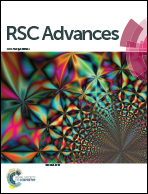Synthesis of one-dimensional Bi2O2CO3–Bi(OHC2O4)·2H2O heterojunctions with excellent adsorptive and photocatalytic performance†
Abstract
A one-dimensional (1D) Bi2O2CO3–Bi(OHC2O4)·2H2O heterostructure was synthesized by a low temperature solution method using Bi(OHC2O4)·2H2O nanorods as templates. Bi2O2CO3 nanosheets vertically grew onto the Bi(OHC2O4)·2H2O rods along the long axial direction. Its adsorption capacity for organic pollutants was evaluated using methyl orange (MO) as a model. The results showed that the Bi2O2CO3–Bi(OHC2O4)·2H2O heterostructure had an excellent adsorption capacity of 95.78 mg g−1 and repeatability for MO. The Bi2O2CO3–Bi(OHC2O4)·2H2O heterostructure also possessed excellent photocatalytic activity to degrade dyes (MO, RhB and MB) under solar/UV light irradiation. 20 mg L−1 of RhB, 30 mg L−1 of MB and 75 mg L−1 of MO could be completely degraded by the Bi2O2CO3–Bi(OHC2O4)·2H2O photocatalyst in 15, 25 and 120 min, respectively. This superior adsorptive and photocatalytic performance is ascribed to the synergistic effect of the big BET surface area and the formation of a number of junctions in the Bi2O2CO3–Bi(OHC2O4)·2H2O heterostructure. A trapping experiment of the active species during the photocatalytic degradation was carried out, and the result indicates that the O2−˙ radical and h+˙ play a major role in the photocatalytic degradation process. This study provides a general and effective method to fabricate a unique 1D Bi2O2CO3–Bi(OHC2O4)·2H2O heterostructure with both photocatalytic and adsorptive performance on a large scale.


 Please wait while we load your content...
Please wait while we load your content...